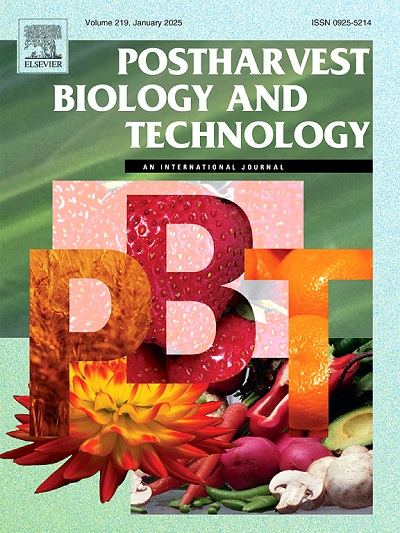转录因子CsWRKY76可能参与水杨酸刺激柑橘果实中天冬酮和五甲基甲黄酮的积累
IF 6.4
1区 农林科学
Q1 AGRONOMY
引用次数: 0
摘要
水杨酸(SA)是柑橘类水果中植物抗菌素的有效激发剂,但SA诱导的抗病转录调控机制尚不清楚。在这里,我们发现CsWRKY76是一个关键转录因子(TF),正调节sa介导的天冬scoparone和3,5,7,3 ',4 ' -pentamethoxyflavone (PMF)在接种意大利青霉的柑橘(citrus sinensis)果皮中的积累。CsWRKY76的表达与植物抗毒素水平密切相关,并被SA显著上调。亚细胞定位证实了其核靶向性,而酵母单杂交(Y1H)检测显示其转录激活并特异性结合W-box基序。柑橘果皮中CsWRKY76的短暂过表达提高了scoparone(74.8% %)和PMF(24.3% %)的水平,并伴有苯丙素途径基因(Cs4CL, CsPAL, CsF6'H1, CsCOMT)的上调。相反,沉默CsWRKY76使scoparone和PMF的积累减少了49.7% %和57.8% %,相关基因下调。值得注意的是,CsWRKY76间接调控了这些生物合成基因,表明存在复杂的调控网络。我们的研究结果阐明了CsWRKY76是柑橘中sa诱导的防御反应的关键调节因子,为增强采后抗病性提供了分子靶点。本文章由计算机程序翻译,如有差异,请以英文原文为准。
Transcription factor CsWRKY76 potentially involved in accumulation of scoparone and pentamethoxyflavone in citrus fruit stimulated by salicylic acid
Salicylic acid (SA) is a potent elicitor of phytoalexins in citrus fruit, yet the transcriptional regulatory mechanisms underlying SA-induced disease resistance remain unclear. Here, we identified CsWRKY76 as a key transcription factor (TF) positively regulating SA-mediated accumulation of scoparone and 3, 5, 7, 3′, 4′-pentamethoxyflavone (PMF) in citrus (Citrus sinensis) peels inoculated with Penicillium italicum. CsWRKY76 expression was strongly correlated with phytoalexin levels and significantly upregulated by SA. Subcellular localization confirmed its nuclear targeting, while yeast one-hybrid (Y1H) assay revealed transcriptional activation and specific binding to the W-box motif. Transient overexpression of CsWRKY76 in citrus peels elevated scoparone (74.8 %) and PMF (24.3 %) levels, concomitant with upregulation of phenylpropanoid pathway genes (Cs4CL, CsPAL, CsF6'H1, CsCOMT). Conversely, silencing CsWRKY76 reduced scoparone and PMF accumulation by 49.7 % and 57.8 % with downregulation of the involved genes. Notably, CsWRKY76 indirectly regulated these biosynthetic genes, suggesting a complex regulatory network. Our findings elucidate CsWRKY76 as a critical regulator of SA-induced defense responses in citrus, providing a molecular target for enhancing postharvest disease resistance.
求助全文
通过发布文献求助,成功后即可免费获取论文全文。
去求助
来源期刊

Postharvest Biology and Technology
农林科学-农艺学
CiteScore
12.00
自引率
11.40%
发文量
309
审稿时长
38 days
期刊介绍:
The journal is devoted exclusively to the publication of original papers, review articles and frontiers articles on biological and technological postharvest research. This includes the areas of postharvest storage, treatments and underpinning mechanisms, quality evaluation, packaging, handling and distribution of fresh horticultural crops including fruit, vegetables, flowers and nuts, but excluding grains, seeds and forages.
Papers reporting novel insights from fundamental and interdisciplinary research will be particularly encouraged. These disciplines include systems biology, bioinformatics, entomology, plant physiology, plant pathology, (bio)chemistry, engineering, modelling, and technologies for nondestructive testing.
Manuscripts on fresh food crops that will be further processed after postharvest storage, or on food processes beyond refrigeration, packaging and minimal processing will not be considered.
 求助内容:
求助内容: 应助结果提醒方式:
应助结果提醒方式:


